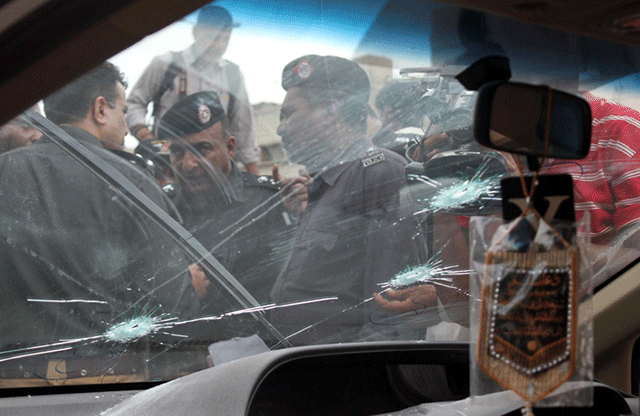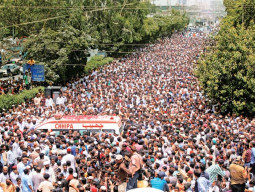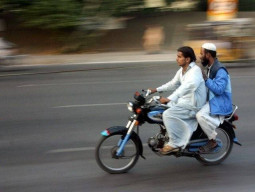
The tragic events of this week have yet again triggered an avalanche of angst amongst a populace habitually on the edge. The whirlwind of conflicting emotions seem to have left us all exhausted — for good reason.
Peace has come to Karachi. No it hasn’t. Zarb-e-Azb has broken the back of terror. Or not. Politicians have finally agreed to the rules of the game. Except maybe not. Governance has taken centre stage. Though not really. Pakistan has turned a corner. And yet remains at the perennial crossroads.
What gives?
In Karachi, the assassination of famed qawwal Amjad Sabri a day after the shock daylight kidnapping of the son of the Chief Justice of Sindh has rent asunder the carefully stitched narrative of peace and calm. The two incidents do not have a seeming connection, and yet they are mentioned in the same breath by a concerned citizenry. Kidnappings in Karachi had not stopped since the return of the peace narrative, and neither sadly had killings. Underneath the veneer of calm, the city kept bleeding from its shoddily bandaged wounds. Yes there was a sense of normalcy triggered by the aggressive presence of the Rangers coupled with the enforced docility of the MQM. The city that braved the most terrible of times was now reveling in tranquillity under the shadow of the official gun.
And yet two high-profile acts of crime seem to have dealt a crippling blow to this tranquil mood. Suddenly a sense of panic and insecurity has rolled in from the sea like a thick fog. Now artistes want security from the state, and soon other segments of society will air similar demands, and perhaps make arrangements. Why was Sabri targeted? Is random killing the new terror tactic? Is this the feared blowback of the operation? Hard targets have secured themselves so soft targets are now fair game? If such questions reflect a growing sense of alarm, that sounds about right.

But does it sound fair? In an age of instant communication and media-driven perceptions, are we lurching from one extreme to the other without any solid reason? Ask a law-enforcement person and he will rattle off a litany of statistics to prove how the situation in Karachi, and in the country in general, has improved dramatically. The script is fairly linear: so many terrorists killed and injured, so many gangs busted, so much ammunition recovered, such-and-such wanted man bumped off, so many percentage points reduction in terror incidents, such a slide in kidnappings for ransom, etc. And etc. You look at the facts and figures sprayed onto your unsuspecting being, you stare at the fancy charts and colour-coded graphs and you think to yourself: what a wonderful world.
And yet it ain’t.
What explains the difference between reality and perception? Two acts of horrendous crime cannot transform a metropolis from a peaceful into an insecure abode. At play here is a subtle force that is solid enough to convince men and women of its presence and yet fluid enough not to be in the grip of any single person or institution. It translates reality on the ground into a series of sounds, images and thoughts that morph into a collective perception about reality.
Confused?
Consider this: how has the reality in Karachi changed over the last year or so? Everyone says there is a palpable decrease in killings, robberies, kidnappings and extortion. Of all the people who say this, only a handful can cite comparative figures to substantiate their point. And even if they did, who trusts these numbers anyway? So the bulk of these people say the situation in Karachi has improved because they feel it has improved. Feel?
How do you feel an improvement? No one roams around the city randomly to check the efficacy of peace (unless you’re a law enforcer or a journalist!) And yet you imagine a betterment because you hear others say it, you are told it is so through the TV, you read so in the newspapers, you witness more people in shops, bazaars and restaurants, you suffer fewer strikes and shutdowns and at social get-togethers you learn less about so-and-so got ransomed and more about so-and-so got proposed. In the end what you believe is based on perceptions created through a series of random narratives stitched together by a bit of reality and a lot of story-telling.
And we all love to hear stories. Such stories do not have to be fiction, for they can be grounded in a lot of reality. But reality means little unless it is delivered to the recipients through a coherent narrative. Did we have a coherent narrative in Karachi? And has it just been shattered?
Perhaps it is prudent to consider that Karachi was never as peaceful as we were told it was. And Karachi is not as insecure as we feel it is now after the high-profile acts of crime this week. The reality of Karachi has not taken a hit. The perception of Karachi has.
And if this be so, does it connect the two high-profile incidents that happened in the city this week? Were they actually a deliberate attempt to puncture the dominant narrative sold by the government and bought by the citizenry? Or would this be giving too much credit to terror outfits supposedly on the run?
In the end, it all boils down to what you believe once this belief has been tempered with a slight dose of reality. The tragic murder of Amjad Sabri and the kidnapping of Awais Shah are harsh realities that are hitting their loved ones the most. But these two tragedies are also triggering wave after wave of perceptions ranging from who and how to why and whence.
Wedged in between are two bitter conclusions: he who influences the arc of narrative can overshadow the bite of reality; and just because you like hearing a story shouldn’t mean you believe it too.
Published in The Express Tribune, June 26th, 2016.
Like Opinion & Editorial on Facebook, follow @ETOpEd on Twitter to receive all updates on all our daily pieces.






















































COMMENTS (1)
Comments are moderated and generally will be posted if they are on-topic and not abusive.
For more information, please see our Comments FAQ